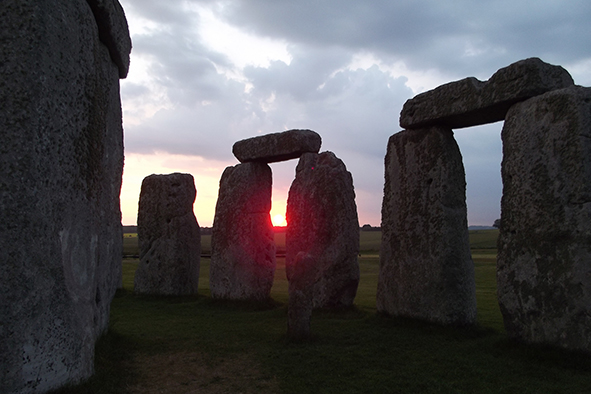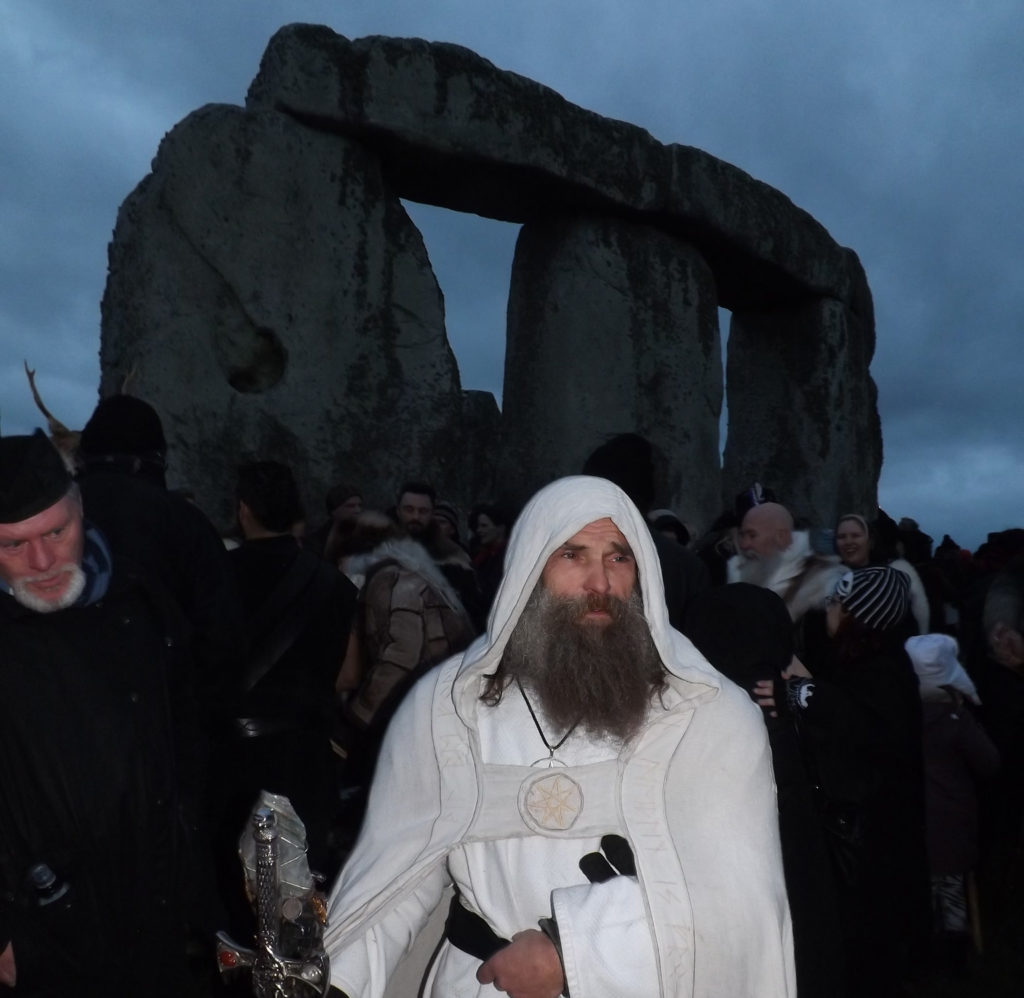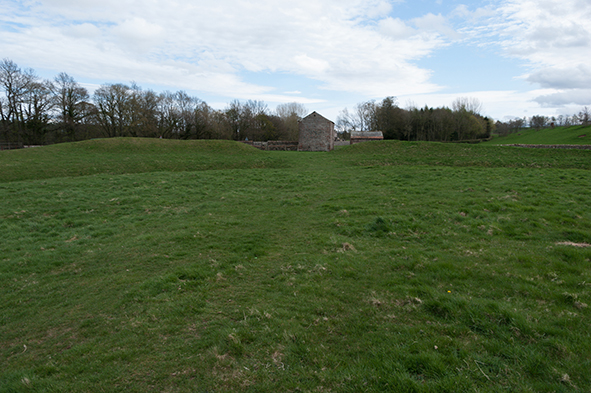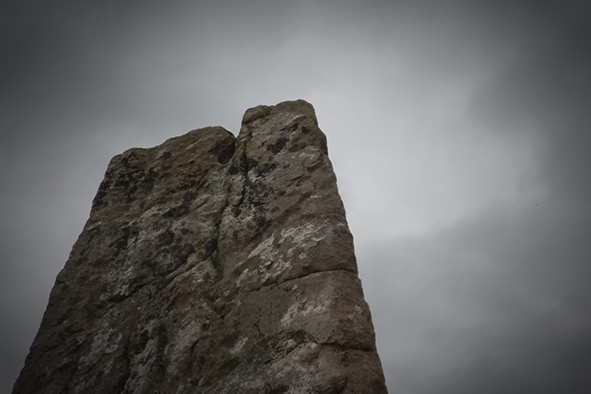There are over 1,300 neolithic stone circles located across the British Isle. Their original purpose lost to prehistory, people across all ages have attributed ancient legends to them and ascribed them spiritual meaning. This lack of information, also makes them a blank slate for the tourist: it is up to the sight-seer to decide what aspect of stone circles is worth seeing.

Stonehenge at sunrise (Photo: Stonehenge Stone Circle via Flickr)
Pre-dawn, the day of the winter solstice, Stonehenge car park. I was about to attend an event that laid the stones, so to speak, of what would go on to become one of the bleakest (temporally at least), most peculiar trips of my life, one that more than any other journey I’ve been on, raised the question of why we visit the places that we do.
Cathy – my girlfriend at the time – and I were jammed tight among pagan crowds of latter day druids and would-be wizards gathering in the blustery darkness of Salisbury Plain, waiting for sunrise.
“Have you seen the dwarf?” Cathy asked.
“I know,” I said, “I’ve been looking at him too.”
The dwarf was attached to a group with a banner that announced them as “The Sutton Neo-Pagans”. He was wearing a gold cloak and holding a staff, though was not talking to anyone.
“Must be quite a coup,” I said, “having a dwarf in your coven.”
“The envy of the solstice,” Cathy agreed.
“Do you think they pay him?”
“He doesn’t look like he’s enjoying himself.”
“It’s half six in the morning, we’re in a muddy field surrounded by motorways in the middle of winter,” I reflected, “No one’s enjoying themselves.”
This was not really true; I was enjoying myself. The pre-dawn had an ancient exoticism I associate with places far more distant from my front door than a two hour drive down the M3. And I was holding on to a vague hope that despite the discomfort and the cloud cover that I might, for want of a better word, “feel” something when among the stones; the solstices being the only time of year when such an intimate experience of Stonehenge is still permitted, being also the time of year for which the monument was supposedly built: at dawn on the solstices, in an instant of profoundly forgotten relevance, the sunrise shines perfectly through Stonehenge’s East/West axis.
Perhaps unsurprisingly, then, there was a strict time schedule to proceedings, and access to the monolith was not granted until very shortly before sun-up. So we soon clogged at the opening to a tunnel that would take us beneath the ring-road of motorways that surrounds the prehistoric monument, playing “count the pointy hats”.
Without ceremony an abrupt forward shuffle began. We crossed under the road, past a small, shut gift shop; from one cold, muddy field into another, and there on the dark rise ahead of us was the most famous pile of rocks in the world.
The walk became a condensed form of pilgrimage; a pre-biblical biblical scene, lit by the slowly greying winter sky, the emergence of which obviously intensified the speed with which the crowds were shuffling toward the Neolithic stones. We’d come all this way and no one wanted to miss the event itself, even if – because of the clouds – none of us were entirely sure how much event there would be to see when we got there; it still seemed likely that the event would miss us.

A modern day druid (Photo: Stonehenge Stone Circle via Flickr)
Cool Stones
On arrival, I positioned myself next to one of the massive stone blocks and reached out a hand to touch it, just to see if anything happened.
“How does it feel?” asked Cathy.
“Cool,” I said.
I was beginning to wonder, though, if this was to be it; whether the solstice at Stonehenge would amount to little more than an act of collective site-seeing, when suddenly a man dressed something like a Pound Shop Gandalf climbed onto a podium that made him appear as though he were flying above the crowds.
“Mote it be!” he called out in a thick Cornish accent – uttering what I was to realise is the pagan “amen”. All eyes swivelled in his direction.
I’m not going to pretend I recall every detail of the Pound Shop Gandalf’s speech (sermon?) save that oddly, rather than concentrating on the glory of the moment, the magical significance of the solstice etc. he spoke mostly about resolving conflicts between various pagan groups.
Stonehenge, it transpired, has all the qualities of a pagan Jerusalem; all the different subgroups believe in its spiritual significance, though there’s little agreement as to just what that spiritual significance is. I took this as heartening; it meant there wasn’t any pressure to have any particular kind of experience here myself. I was my own pagan faction of one. Perhaps later Cathy and I would hash out a few core beliefs but right that second I was in the glorious intuitive stages of my own birthing religion, and it felt… cool.
Pound Shop Gandalf did eventually get to saying a few words about Stonehenge and the solstice – though he was ploughing such a furrow between various extreme pagan opinions that they amounted to little but bland platitudes about peace, love, the earth mother etc.
At some point while he was talking, though, the clouds started to clear on the Eastern horizon, and against the odds, rather than a slow paling of the world, we were treated to actual dawn.
Thus, while the speech fizzled, nature’s own rhetoric, combined with that of the stones (which are so old as to almost be counted as part of nature themselves) was still building to an awesome crescendo.
Pound Shop Gandalf had finished speaking when the wonder of the sunrise fully revealed itself – growing from a red laser-like scar to a vast bloom of pinks and orange, spitting black cirrus clouds, as though a volcano were erupting in slow motion across the sky.
I suppose the fact that the speech was over meant that in spite of this amazing dawn we had still technically missed what we had come to Stonehenge to see – the perfect alignment of first light of the new year with the monument’s axis. But that did not matter, and the glow of sunrise really did feel like the welcoming in of summer – as the northern hemisphere took its first steps away from the dark.
Of Stones and Sheep

Views out across the Lake District (Photo: Simons Images via Flickr)
After Christmas and New Year – those two commercially appropriated strands of the solstice – Cathy and I decided to continue our exploration of Britain’s ancient past, and set off to the Lake District in search of more neglected stone circles. There are over 1,300 in the British Isles and still no one really knows why or how they were constructed. It’s long been assumed that they must have had some kind of religious significance, but even that cannot be proved.
Officially the seasons may have been on their way back to the light, but in reality winter had descended with a savage weight the day we departed, doing so under skies of soot and coal. Inside our car, the air was a dry and toasty too-warm; it was a drowsy, civilised cocoon in which we hurtled north into the early falling night.
Our first evening was spent in the embodiment of an Agatha Christie novel. An old coaching inn, whose name I have now long forgotten, though was probably something suitably bleak like “The Hangman’s Rest”, at the foot of some hauntingly forested hill, which we approached amid rain and thunder.
We were welcomed by a polite woman from New Zealand, dressed in the all-black of chain pubs, who told us that the inn’s Thai kitchen was closing shortly. And so it was that over a jungle curry, while the storm continued to beat hard at the windows, we talked stone circles.
Cathy and I talked about how they are monuments to dream over; that they could be whatever we wanted of them; how they should be felt more than understood: easy things to say when you are dry and warm.
By the morning the wind had cleared a brief patch of milky blue sky and we emerged from the hotel into an aqueous dawn. Everything was wet. Even the dry stone walls had taken on the aspect of piles of saturated sponges cutting like reefs across rolling fields of seaweed green. I had never – and have never since – felt so cold. The day possessed the kind of damp chill that didn’t just eat into your bones, it feasted on them. Nevertheless, after a half hour back in the trusty Peugeot with the heater on full we were soon comfortable, wending our way into the Lake District proper.
“It’s there!” Cathy cried, shortly after lunch. “Look, there. Stones!”
“What, you mean that sheep?”
“That’s not a sheep.”
I stopped the car in order to look properly into the field Cathy was talking about.
“It is a sheep,” I said, but of course it was not.
We clambered into the field over a rotting wood stile, then tramped through thick tufts of stubby grass and thistle, wind gusts scything through our winter clothes, towards the literal definition of an anti-climax: the stone circle’s un-impressiveness built with every step closer to it that we took.
From the car there had seemed something beguilingly mysterious to them. Questions of why this godforsaken field had been chosen in the first place, the very loneliness of the stones, the imagining of people dressed in nothing but furs hauling them all this way in the bitter elements; the grand overarching why?
But as we entered the outside world those bitter elements began quickly to take serious chunks out of my capacity for romantic reflection. I suppose this ought to have left me feeling all the more impressed by the hardiness of the circle’s architects, but mainly it just left me feeling, well, cold. And as I got closer to the stone circle its accompanying mystery seemed to incrementally depart while its solid reality asserted itself; that all it was, was what it advertised itself to be: a circle of stones.
Perhaps had I known something about geology I may have been mildly interested that the stones were of some non-indigenous origin; that they came from another field, a more naturally stony field, perhaps. But as it was I was struck only by their overwhelming normality, and was left completely lost as to what had made this place, in the eyes of some historically distant tribe, in any way special. The grand overarching why returned, though this time it had a more personal focus: why were we there?
It wasn’t long after standing in the centre of the freezing circle that something else more interesting caught Cathy’s eye.
“Look,” she pointed, “sheep!”
King Arthur’s Table

Arthur’s Round Table – proof that even in the daytime there isn’t much to see (Photo: Jerry Kociatkiewicz via Flickr)
The stone circle we were headed for next was the evocatively named “King Arthur’s Table”. It’s natural enough that a lot of these sites are linked with the Arthurian legends, their original construction lost in the mists of prehistory. Stonehenge is said by some to have been built by Merlin, while King Arthur’s Table is supposedly the sunken remains of the famously round furniture piece that gave the old King’s knights their collective name. So far so worthy of a visit.
King Arthur’s Table was not so much beside the busy junction as partially underneath it. It seemed that in spite of the bountiful amount of space open to road planners in the Lake District they had acted with what could almost be taken for a deliberate disregard for history. Though I almost could not blame them.
King Arthur’s Table was barely a stone circle, more just a slightly raised green mound in a circle shape. The only thing I could see that gave away its historic status was an information sign, which – if it were possible – actually served to lessen the magic of the place by informing us that the legend about it being King Arthur’s round-table was not only probably untrue, but didn’t even have a backing in myth.
We had at last managed to cross the road – finding the briefest gap between the endless cars – and were squelching around King Arthur’s Table, just to make sure we had really seen it, even though there was nothing really to see. Then, out of nowhere Cathy started to laugh. It began as a giggle, but soon she was throwing out big belly-ache chuckles into the freezing night. For a moment I didn’t understand. There didn’t seem anything especially funnier about this side of the road than the other. Then I got it; Cathy was laughing at us, at the pure ridiculousness of what we were doing. It was the opposite of site-seeing – a holiday to the void.
I started to laugh as well. And before long we were both hysterical, wheezing on the black air, as though possessed, after all, by the place’s ancient magic, which had not been killed by the road, or the rain, or the cold, but rather made stronger by them. And for a moment, our presence there made sense.
We spent the night in another pub. This one cosy and gloriously English. The only other customers were two ruddy old men not so much playing darts as standing near the dart board while they talked and drank. In the small, intimate space, it was inevitable that they got around to asking us what we were doing in the Lake District so far out of season.
“Stone circles, eh?” the slightly ruddier of the two responded when we’d explained it to them. “Well then, you’ll be wanting to see Long Meg and Her Daughters.”
“Who are they?” I asked, stupidly.
“They,” he said, “were a coven of witches. And they were meeting on a night like this, up by Skalkeld years and years before it had that name.”
“What were they doing?” Cathy asked
It was a decent question, I thought: even a coven of ancient legendary witches would have had to be crazy to go out on a night like this.
“Searching for stone circles probably,” I suggested.
“Black magic,” the man telling me the story said with an exaggerated wink.
I couldn’t help but think of Cathy and I laughing manically at King Arthur’s Table just an hour before; how if someone had chanced upon us they may have mistaken our behaviour for that of two people in the midst of some pagan rite.
“And?” Cathy asked.
“And they they were discovered by a wandering magician called Michael Scot.”
What were all these people doing walking around on horrible stormy nights?
“And he used powerful magic to lock the witches in stone.”
“Ah…” I said, understanding where this story was going. “And they were standing in a circle, right?”
“All aside from Meg herself. Meg Meldon was stood away from her daughters then, and she still is now, keeping an eye on them, an eye that still glistens with the sun at sunset on solstice eve.”
This was solid tourist board sanctioned stuff, but the man seemed to be genuinely excited by it, and he was still going:
“The strange thing is, there isn’t anyone who’s been able to count how many stones there are.”
“What do you mean?” I said. “You mean like there lots of little stones too, that you don’t know if you should really count them as stones?”
“It’s said,” the man continued, ignoring me, “that if you can count the stones of Long Meg and her Daughters twice and both times come to the same total, then you break Michael Scot’s spell, and release the witches back on the world.”
I didn’t have to look across to know that Cathy was grinning, and that the next day we would be counting stones.
Trying to Count Meg’s Daughters

A detail of Long Meg (Photo: Peter Blundell via Flickr)
It was still just as cold when we arrived at Long Meg and Her Daughters, but it had at least stopped raining, and from the stone circle’s elevated position we could see the Lake District’s glittering magnificence. Dark clouds ribboned a sky that was otherwise golden with winter light.
The stones themselves were tall and threw even taller shadows, with Long Meg stark and alone, a monolithic monolith, and tallest of them all. Here at last, I thought, was a special place. Even the hungry wind did little to gnaw at my contented reflection. Perhaps it had been the story we’d been told in the pub the night before – the landscape given substance by living tradition rather than by just something I’d read in a book or on a park sign – or perhaps it was simply a combination of dramatic weather and a site that was worth seeing.
The stones themselves were scrawled with anciently impenetrable hieroglyphs, easy to imagine as the design of a sorcerer made to restrain dark power. And sure enough Long Meg herself had a single sparkling eye. A diamond was inset in the stone; the witch was keeping vigil still.
Cathy and I had finished our first count and both, satisfactorily had made it 29 stones. We were beginning on our second, when the wind really began to pick up and out across the lakes the black ribbons of cloud began to gather together then roll our way.
I’ve never seen a weather front move with such speed: a pyroclastic flow of storm was coming fast in our direction, and now I could hear thunder and see lighting bursts from the cloud. It was as if by commencing our second count we had begun, indeed, to unlock the spell which kept Meg and her daughters frozen in stone. The circle was, almost literally, coming to life.
“I think we should leave,” Cathy shouted above the gathering wind.
“What about counting them again?” I called back, though I already knew this was better left incomplete. Something seemingly magic was happening right now, why pursue it to its realistic conclusion and prove otherwise?
For a moment the history and landscape were alive with beautiful irrationality, our journey to find stone circles had to end there. It was for this moment of perfect incompletion that we had come. And so we headed back to the car before we became again just two people in a cold and muddy field in the middle of a storm.